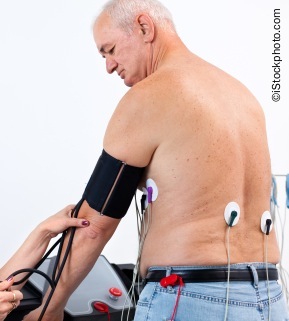It is sometimes appropriate to refer for surgery just before symptoms develop to avoid the sharp early rise in mortality (see figure 3).18 The risk of symptom onset is partly related to the grade of severity:19
The likelihood of remaining alive without valve replacement at two years was:
- 21±18% for a jet velocity at entry >4.0 m/s
- 66±13% for a jet velocity of 3.0 to 4.0 m/s
- 84±16% for a jet velocity <3.0 m/s (P<.0001)19
A particularly high risk of imminent symptom-onset is associated with:
- A combination of an increase in peak velocity ≥0.3 m/s per year and heavy valve calcification20
- Peak velocity >5.5 m/s17
- Symptoms on exercise testing21
These are all recognised indications for surgery in apparently asymptomatic patients provided that the surgical risk is low (class IIa, level C).1, 22,
Symptoms
Classical symptoms of AS are:
- dyspnoea on exertion
- angina on exertion
- dizziness or syncope on exertion
 The recognition of symptoms may be difficult, because patients may limit activity to reduce breathlessness. Direct and thorough questioning of patients is vital to ensure subtle early symptoms are not ignored. A reduction in exercise capacity counts as a symptom. Dyspnoea is the most common first symptom.19,23 This is from either a stiff, hypertrophied and non-compliant left ventricle or, less commonly, from left ventricular (LV) systolic dysfunction.
The recognition of symptoms may be difficult, because patients may limit activity to reduce breathlessness. Direct and thorough questioning of patients is vital to ensure subtle early symptoms are not ignored. A reduction in exercise capacity counts as a symptom. Dyspnoea is the most common first symptom.19,23 This is from either a stiff, hypertrophied and non-compliant left ventricle or, less commonly, from left ventricular (LV) systolic dysfunction.
Angina occurs in approximately two thirds of patients with severe AS, but only half of these will have clinically significant coronary artery disease.19,23 Exercise-induced syncope, or pre-syncope, probably results from peripheral vasodilatation in the presence of an inability to increase cardiac output in order to maintain cerebral perfusion. However a tachy- or brady-arrhythmia may also occur. Calcification of conducting tissue, which lies adjacent to the aortic valve annulus, may result in atrioventricular (AV) block, causing dizziness or syncope at rest.
Physical signs
The murmur of AS is a harsh crescendo–decrescendo systolic murmur, usually loudest at the base of the heart, radiating to the carotids, and louder in expiration. However it may be heard widely all over the precordium and may on occasion, be maximal at the apex. In general, the volume of the murmur relates to pressure gradient and jet velocity;24–26 however in obese patients, those with co-existent lung disease, or a low cardiac output, the murmur will be quieter regardless of severity.
The peak of the murmur comes later in systole as disease progresses and the second sound becomes quieter and ultimately silent.
Aortic stenosis
Moderate aortic stenosis
Severe aortic stenosis
With increasing severity of stenosis, the pulse at the carotid will peak later in systole (like the murmur), and be of lower amplitude; this results in a ‘slow rising’, low amplitude pulse. However, the character of the carotid pulse may be affected by other factors, so the absence of a slow-rising carotid pulse does not preclude severe stenosis.
A low systolic and narrow pulse pressure used to be thought a sign of severe AS when young patients presented with rheumatic disease. However our population is now older and frequently has coexistent systemic hypertension. The blood pressure is no longer a reliable sign of AS.
Summary
AS is a slowly progressive disease. In the asymptomatic phase, it has a low mortality and morbidity, but outcome changes significantly with symptom onset. Symptoms may be insidious in onset, and masked by limiting activities, therefore close follow up with careful echo monitoring and appropriate questioning is essential.
Patients most commonly present with dyspnoea. Angina, with or without significant coronary disease, and syncope are also classic symptoms of AS and should prompt consideration of surgery, if appropriate.
